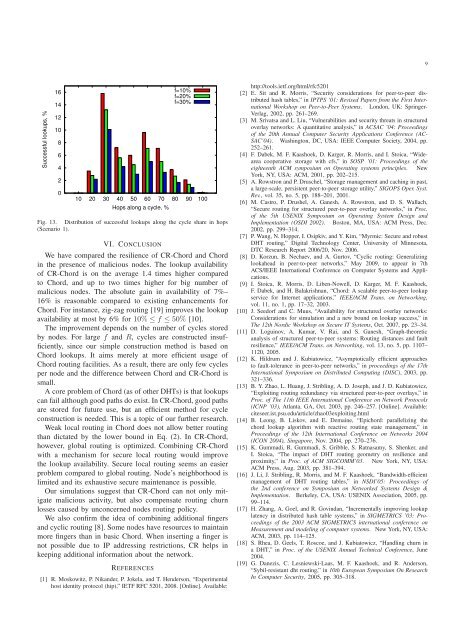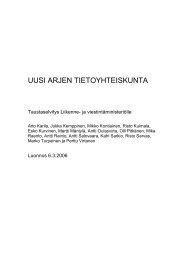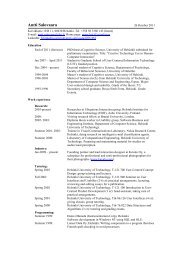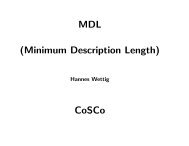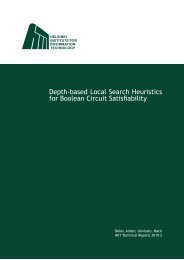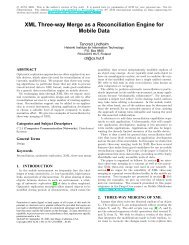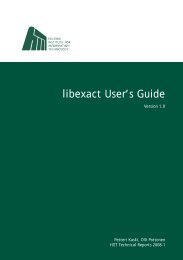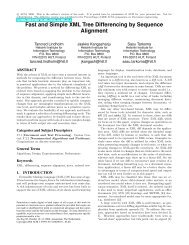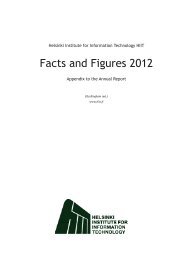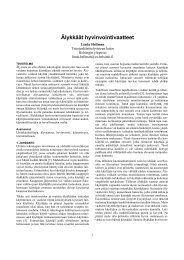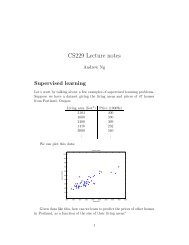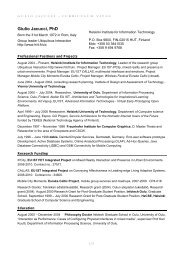Improving Lookup Availability in the Presence of Malicious DHT Nodes
Improving Lookup Availability in the Presence of Malicious DHT Nodes
Improving Lookup Availability in the Presence of Malicious DHT Nodes
Create successful ePaper yourself
Turn your PDF publications into a flip-book with our unique Google optimized e-Paper software.
9<br />
Successful lookups, %<br />
16<br />
14<br />
12<br />
10<br />
8<br />
6<br />
4<br />
2<br />
0<br />
10 20 30 40 50 60 70 80 90 100<br />
Hops along a cycle, %<br />
f=10%<br />
f=20%<br />
f=30%<br />
Fig. 13. Distribution <strong>of</strong> successful lookups along <strong>the</strong> cycle share <strong>in</strong> hops<br />
(Scenario 1).<br />
VI. CONCLUSION<br />
We have compared <strong>the</strong> resilience <strong>of</strong> CR-Chord and Chord<br />
<strong>in</strong> <strong>the</strong> presence <strong>of</strong> malicious nodes. The lookup availability<br />
<strong>of</strong> CR-Chord is on <strong>the</strong> average 1.4 times higher compared<br />
to Chord, and up to two times higher for big number <strong>of</strong><br />
malicious nodes. The absolute ga<strong>in</strong> <strong>in</strong> availability <strong>of</strong> 7%–<br />
16% is reasonable compared to exist<strong>in</strong>g enhancements for<br />
Chord. For <strong>in</strong>stance, zig-zag rout<strong>in</strong>g [19] improves <strong>the</strong> lookup<br />
availability at most by 6% for 10% ≤ f ≤ 50% [10].<br />
The improvement depends on <strong>the</strong> number <strong>of</strong> cycles stored<br />
by nodes. For large f and R, cycles are constructed <strong>in</strong>sufficiently,<br />
s<strong>in</strong>ce our simple construction method is based on<br />
Chord lookups. It aims merely at more efficient usage <strong>of</strong><br />
Chord rout<strong>in</strong>g facilities. As a result, <strong>the</strong>re are only few cycles<br />
per node and <strong>the</strong> difference between Chord and CR-Chord is<br />
small.<br />
A core problem <strong>of</strong> Chord (as <strong>of</strong> o<strong>the</strong>r <strong>DHT</strong>s) is that lookups<br />
can fail although good paths do exist. In CR-Chord, good paths<br />
are stored for future use, but an efficient method for cycle<br />
construction is needed. This is a topic <strong>of</strong> our fur<strong>the</strong>r research.<br />
Weak local rout<strong>in</strong>g <strong>in</strong> Chord does not allow better rout<strong>in</strong>g<br />
than dictated by <strong>the</strong> lower bound <strong>in</strong> Eq. (2). In CR-Chord,<br />
however, global rout<strong>in</strong>g is optimized. Comb<strong>in</strong><strong>in</strong>g CR-Chord<br />
with a mechanism for secure local rout<strong>in</strong>g would improve<br />
<strong>the</strong> lookup availability. Secure local rout<strong>in</strong>g seems an easier<br />
problem compared to global rout<strong>in</strong>g. Node’s neighborhood is<br />
limited and its exhaustive secure ma<strong>in</strong>tenance is possible.<br />
Our simulations suggest that CR-Chord can not only mitigate<br />
malicious activity, but also compensate rout<strong>in</strong>g churn<br />
losses caused by unconcerned nodes rout<strong>in</strong>g policy.<br />
We also confirm <strong>the</strong> idea <strong>of</strong> comb<strong>in</strong><strong>in</strong>g additional f<strong>in</strong>gers<br />
and cyclic rout<strong>in</strong>g [8]. Some nodes have resources to ma<strong>in</strong>ta<strong>in</strong><br />
more f<strong>in</strong>gers than <strong>in</strong> basic Chord. When <strong>in</strong>sert<strong>in</strong>g a f<strong>in</strong>ger is<br />
not possible due to IP address<strong>in</strong>g restrictions, CR helps <strong>in</strong><br />
keep<strong>in</strong>g additional <strong>in</strong>formation about <strong>the</strong> network.<br />
REFERENCES<br />
[1] R. Moskowitz, P. Nikander, P. Jokela, and T. Henderson, “Experimental<br />
host identity protocol (hip),” IETF RFC 5201, 2008. [Onl<strong>in</strong>e]. Available:<br />
http://tools.ietf.org/html/rfc5201<br />
[2] E. Sit and R. Morris, “Security considerations for peer-to-peer distributed<br />
hash tables,” <strong>in</strong> IPTPS ’01: Revised Papers from <strong>the</strong> First International<br />
Workshop on Peer-to-Peer Systems. London, UK: Spr<strong>in</strong>ger-<br />
Verlag, 2002, pp. 261–269.<br />
[3] M. Srivatsa and L. Liu, “Vulnerabilities and security threats <strong>in</strong> structured<br />
overlay networks: A quantitative analysis,” <strong>in</strong> ACSAC ’04: Proceed<strong>in</strong>gs<br />
<strong>of</strong> <strong>the</strong> 20th Annual Computer Security Applications Conference (AC-<br />
SAC’04). Wash<strong>in</strong>gton, DC, USA: IEEE Computer Society, 2004, pp.<br />
252–261.<br />
[4] F. Dabek, M. F. Kaashoek, D. Karger, R. Morris, and I. Stoica, “Widearea<br />
cooperative storage with cfs,” <strong>in</strong> SOSP ’01: Proceed<strong>in</strong>gs <strong>of</strong> <strong>the</strong><br />
eighteenth ACM symposium on Operat<strong>in</strong>g systems pr<strong>in</strong>ciples. New<br />
York, NY, USA: ACM, 2001, pp. 202–215.<br />
[5] A. Rowstron and P. Druschel, “Storage management and cach<strong>in</strong>g <strong>in</strong> past,<br />
a large-scale, persistent peer-to-peer storage utility,” SIGOPS Oper. Syst.<br />
Rev., vol. 35, no. 5, pp. 188–201, 2001.<br />
[6] M. Castro, P. Drushel, A. Ganesh, A. Rowstron, and D. S. Wallach,<br />
“Secure rout<strong>in</strong>g for structured peer-to-peer overlay networks,” <strong>in</strong> Proc.<br />
<strong>of</strong> <strong>the</strong> 5th USENIX Symposium on Operat<strong>in</strong>g System Design and<br />
Implementation (OSDI 2002). Boston, MA, USA: ACM Press, Dec.<br />
2002, pp. 299–314.<br />
[7] P. Wang, N. Hopper, I. Osipkiv, and Y. Kim, “Myrmic: Secure and robust<br />
<strong>DHT</strong> rout<strong>in</strong>g,” Digital Technology Center, University <strong>of</strong> M<strong>in</strong>nesota,<br />
DTC Research Report 2006/20, Nov. 2006.<br />
[8] D. Korzun, B. Nechaev, and A. Gurtov, “Cyclic rout<strong>in</strong>g: Generaliz<strong>in</strong>g<br />
lookahead <strong>in</strong> peer-to-peer networks,” May 2009, to appear <strong>in</strong> 7th<br />
ACS/IEEE International Conference on Computer Systems and Applications.<br />
[9] I. Stoica, R. Morris, D. Liben-Nowell, D. Karger, M. F. Kaashoek,<br />
F. Dabek, and H. Balakrishnan, “Chord: A scalable peer-to-peer lookup<br />
service for Internet applications,” IEEE/ACM Trans. on Network<strong>in</strong>g,<br />
vol. 11, no. 1, pp. 17–32, 2003.<br />
[10] J. Seedorf and C. Muus, “<strong>Availability</strong> for structured overlay networks:<br />
Considerations for simulation and a new bound on lookup success,” <strong>in</strong><br />
The 12th Nordic Workshop on Secure IT Systems, Oct. 2007, pp. 23–34.<br />
[11] D. Logu<strong>in</strong>ov, A. Kumar, V. Rai, and S. Ganesh, “Graph-<strong>the</strong>oretic<br />
analysis <strong>of</strong> structured peer-to-peer systems: Rout<strong>in</strong>g distances and fault<br />
resilience,” IEEE/ACM Trans. on Network<strong>in</strong>g, vol. 13, no. 5, pp. 1107–<br />
1120, 2005.<br />
[12] K. Hildrum and J. Kubiatowicz, “Asymptotically efficient approaches<br />
to fault-tolerance <strong>in</strong> peer-to-peer networks,” <strong>in</strong> proceed<strong>in</strong>gs <strong>of</strong> <strong>the</strong> 17th<br />
International Symposium on Distributed Comput<strong>in</strong>g (DISC), 2003, pp.<br />
321–336.<br />
[13] B. Y. Zhao, L. Huang, J. Stribl<strong>in</strong>g, A. D. Joseph, and J. D. Kubiatowicz,<br />
“Exploit<strong>in</strong>g rout<strong>in</strong>g redundancy via structured peer-to-peer overlays,” <strong>in</strong><br />
Proc. <strong>of</strong> The 11th IEEE International Conference on Network Protocols<br />
(ICNP ’03), Atlanta, GA, Oct. 2003, pp. 246–257. [Onl<strong>in</strong>e]. Available:<br />
citeseer.ist.psu.edu/article/zhao03exploit<strong>in</strong>g.html<br />
[14] B. Leong, B. Liskov, and E. Dema<strong>in</strong>e, “Epichord: paralleliz<strong>in</strong>g <strong>the</strong><br />
chord lookup algorithm with reactive rout<strong>in</strong>g state management,” <strong>in</strong><br />
Proceed<strong>in</strong>gs <strong>of</strong> <strong>the</strong> 12th International Conference on Networks 2004<br />
(ICON 2004), S<strong>in</strong>gapore, Nov. 2004, pp. 270–276.<br />
[15] K. Gummadi, R. Gummadi, S. Gribble, S. Ratnasamy, S. Shenker, and<br />
I. Stoica, “The impact <strong>of</strong> <strong>DHT</strong> rout<strong>in</strong>g geometry on resilience and<br />
proximity,” <strong>in</strong> Proc. <strong>of</strong> ACM SIGCOMM’03. New York, NY, USA:<br />
ACM Press, Aug. 2003, pp. 381–394.<br />
[16] J. Li, J. Stribl<strong>in</strong>g, R. Morris, and M. F. Kaashoek, “Bandwidth-efficient<br />
management <strong>of</strong> <strong>DHT</strong> rout<strong>in</strong>g tables,” <strong>in</strong> NSDI’05: Proceed<strong>in</strong>gs <strong>of</strong><br />
<strong>the</strong> 2nd conference on Symposium on Networked Systems Design &<br />
Implementation. Berkeley, CA, USA: USENIX Association, 2005, pp.<br />
99–114.<br />
[17] H. Zhang, A. Goel, and R. Gov<strong>in</strong>dan, “Incrementally improv<strong>in</strong>g lookup<br />
latency <strong>in</strong> distributed hash table systems,” <strong>in</strong> SIGMETRICS ’03: Proceed<strong>in</strong>gs<br />
<strong>of</strong> <strong>the</strong> 2003 ACM SIGMETRICS <strong>in</strong>ternational conference on<br />
Measurement and model<strong>in</strong>g <strong>of</strong> computer systems. New York, NY, USA:<br />
ACM, 2003, pp. 114–125.<br />
[18] S. Rhea, D. Geels, T. Roscoe, and J. Kubiatowicz, “Handl<strong>in</strong>g churn <strong>in</strong><br />
a <strong>DHT</strong>,” <strong>in</strong> Proc. <strong>of</strong> <strong>the</strong> USENIX Annual Technical Conference, June<br />
2004.<br />
[19] G. Danezis, C. Lesniewski-Laas, M. F. Kaashoek, and R. Anderson,<br />
“Sybil-resistant dht rout<strong>in</strong>g,” <strong>in</strong> 10th European Symposium On Research<br />
In Computer Security, 2005, pp. 305–318.


